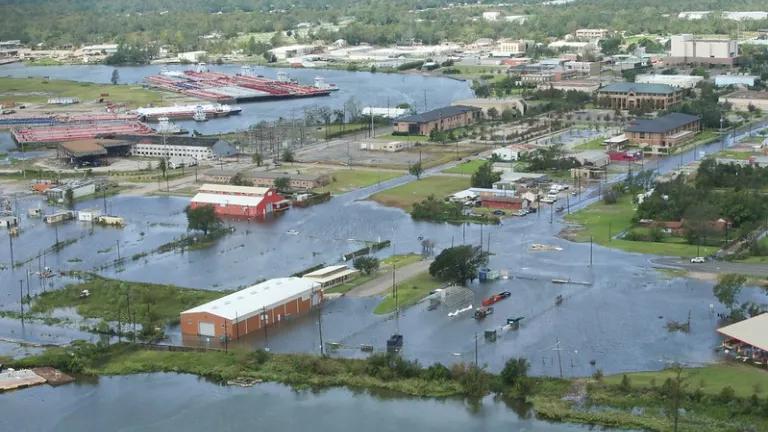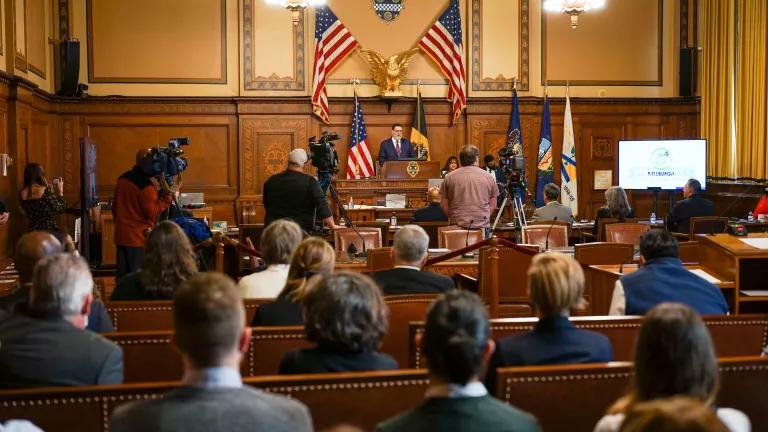Laura: The Latest Climate Disaster for Low-Income Americans

Cameron, Louisiana was devastated for the third time in 15 years when Hurricane Laura came ashore. In 2005, Hurricane Rita pushed 12 to18 feet of water through this town. In 2008 Hurricane Ike sent 10 feet of surge before making landfall in Galveston, Texas. In so many ways, this area has been recovering from disasters for the past fifteen years. Climate change guarantees that it won’t be the last one.
Now this community, and many others stretching from Port Arthur, Texas to Lake Charles, Louisiana and beyond are reeling from the 10 feet of storm surge, torrential rains, and record-breaking winds that Laura brought.
“There ain’t nothing to come back to,” Cameron resident Adley Dyson Jr. told the Washington Post. “I’m 47 years old. I had to start over in my late 20s. I had to start over in my 30s. This is my fourth time starting over. I don’t want to have to start over again.”
Hurricane Laura is yet another reminder of how low-income communities and communities of color are most vulnerable to climate-fueled disasters. The parishes in southwest Louisiana have an 18 percent poverty rate and 20 percent of residents are Black or Hispanic.
Across the country, communities of color and low-income communities are more likely to reside in vulnerable areas. This is due, in part, to redlining and other discriminatory housing policies and practices.
They are less likely to have the financial resources or access to credit to make their home safer before a disaster strikes (e.g., by raising a home on pilings to avoid flood waters). And they are less likely to be able to afford things like flood insurance coverage, which would give them more financial capacity to rebuild after a flood, something my colleague Joel Scata writes about.
Not that flood insurance is a panacea. It doesn’t stop floods from happening. It helps with the cost of rebuilding, but that may not be the best option if your home’s flooded multiple times in 15 years. After rebuilding so many times, you might prefer to relocate. Flood insurance won’t help you do that, a problem that I looked at in-depth in the report Seeking Higher Ground.
Post-disaster assistance is not as easy to secure as it should be
One might reasonably expect that this is where federal disaster aid comes in, to ensure that people who most need assistance can quickly get back on their feet and resume life, or perhaps get assistance to make their home safer in the future. But that’s not everyone’s experience.
FEMA, and many other federal agencies, distribute much-needed aid to disaster survivors. However, the process for applying and the documentation requirements can leave many frustrated in their attempts to secure the assistance they desperately need.
Unfortunately, federal disaster aid tends to flow to the communities and individuals that get to the front of the line first, rather than who needs assistance the most. That’s not the intention, but it’s a consequence of the nation’s disaster policies and the byzantine procedures disaster survivors must navigate to seek assistance. Groups like the Disaster Housing Coalition and The Urban Institute have documented the difficulties people face in securing a lifeline in the aftermath of a disaster like Hurricane Laura.
Some survivors of Hurricane Laura could face similar problems as those in Texas and Puerto Rico after Hurricanes Harvey and Maria. In Texas, low income applicants for aid were denied FEMA Individual Assistance at rates almost twice as high as higher income applicants. After Maria, tens of thousands were denied FEMA assistance due to lack of documentation, because they didn’t have traditional titles to the homes they owned and lived in. FEMA worked to address this problem in Puerto Rico, but similar issues could arise in areas hit by Laura, where properties have been passed down over the generations without titles being documented.
During the recovery, it doesn’t get easier for these communities
How post-disaster recovery and disaster mitigation dollars are allocated contribute to the pre-existing equity gap and a resilience gap. The way these dollars are distributed is probably putting further distance between the haves and the have-nots.
Large portions of federal recovery dollars are administered directly by the states, who have a big say in where dollars are spent and which communities get resources. That can introduce additional biases to who gets the dollars and the technical assistance needed for long-term recovery.
Two years after Hurricane Harvey, people in Port Arthur filed a lawsuit to get their fair share of recovery funding from the State of Texas. In the aftermath of that storm, the state gave whiter, more affluent communities a larger share of funding, compared to places like Port Arthur, where damages were arguably much more severe.
Similar issues can arise when communities looks at ways to decrease their vulnerability to future disasters. Depending on where you live, all options may not be equally available to all communities. The more expensive a project is, the more likely an urban or affluent area will benefit. That bias can be driven by the requisite benefit-cost analysis.
Benefits, such as avoided damages, will be higher for projects that protect higher value homes. As a result, expensive engineered solutions like seawalls or beach replenishment projects tend to be built in more affluent communities.
Think of it this way. If a seawall costs $20 million to build and could either protect 100 homes worth $100,000 each (total value of $10 million) or 50 homes worth $500,000 each (total value of $25 million), where would it be built? If you answered, “the location with fewer homes worth more money,” then you have a basic understanding of how benefit-cost analysis works.
A study last year by Jesse Keenan and A.R. Siders looked at disaster mitigation projects in North Carolina and found that this is essentially what happens. More affluent communities tended to benefit from expensive engineered solutions. These communities are also probably better situated to pay the non-federal cost share requirements typical of such projects.
The bias we bring with the disaster data we choose
We have a tendency to measure and compare storms by the dollars of damage….not the human misery inflicted, which is more difficult to quantify. We track the number of “billion dollar storms”, tally the properties damaged or destroyed, report the dollar value of flood insurance damage claims, etc. We focus on the properties, rather than the people. We focus on the financial cost, rather than the human cost.
I’m as guilty of that as anybody. These numbers are readily available and convenient to use. But they only tell only part of the story.
Flood insurance statistics are biased by how many people actually have flood insurance. In the areas affected by Hurricane Laura, only about 17 percent of households appear to have coverage and only 11 percent have coverage in predominantly Black census tracts. When fewer people have insurance, the reported claims and damages paid will be lower than the actual damage that occurred.
Data on flood insurance damage claims are similarly biased by the value of the insured property. Among homes that have been repeatedly damaged by floods, NRDC found that lower value homes incur higher damage relative to property value. On average, single-family homes worth less than $250,000 suffered flood damages that are 122 percent of the property’s value, while the damage to homes worth more than $250,000 was 53 percent of the property value.
Those numbers indicate that a less affluent family living in a lower value home is likely to suffer relatively more extensive damage, perhaps making it more likely the home is uninhabitable or requires more time consuming repairs. While the dollar value of damage claims may be higher for larger, more expensive homes, the damage relative to value of the home may be less.
All of the common metrics discussed above have one thing in common: they tend to diminish suffering and the severity of damage done to poorer people or communities of color.
That may be part of the reason Hurricane Laura, and the hundreds of thousands of people impacted by this terrible storm, have fallen out of the national spotlight so quickly.
Laura didn’t hit a major city and the numbers we often rely upon to signal how terrible a storm was (damages, economic losses, etc.) aren’t of the same scale as a Hurricanes Harvey, Sandy, or Katrina. Or perhaps the now relentless pace of disasters has numbed us to these events (2020 is certainly pushing the boundaries on that argument).
But for those who have had their lives turned upside down by Hurricane Laura, they face yet another difficult recovery—their third in 15 years.
Other Resources on Equity and Disasters
7 Principles of Disaster Recovery, Disaster Housing Coalition-National Low-Income Housing Coalition.
In the Eye of the Storm: A People’s Guide to Transforming Crisis and Advancing Equity in the Disaster Continuum Toolkit, National Association for the Advancement of Colored People.
Damages Done: The Longitudinal Impacts of Natural Hazards on Wealth Inequality in the United States, Social Problems, August 2018.
The Effect of Natural Disasters on Economic Activity in US Counties: A Century of Data, National Bureau of Economic Research, May 2017.
Insult to Injury: Natural Disasters and Residents’ Financial Health, Urban Institute, April 2019.
Louisiana’s population is already moving to escape climate catastrophe, Quartz, September 2020.




